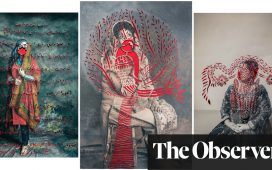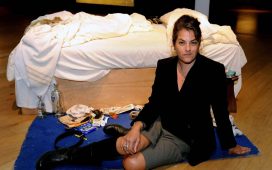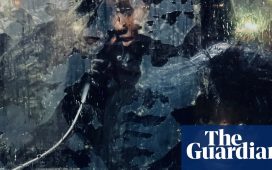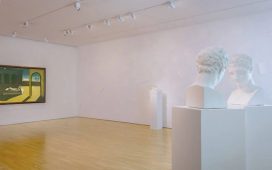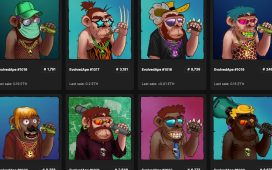I was so engrossed by Reverb’s first installation I struggled to get past it. Stan Douglas’s Luanda-Kinshasa is a masterpiece of filmed live music, here projected in the long, sloping concrete vestibule of the subterranean warren of 180 Studios. I could easily have sat through all six hours of it. When I did finally drag myself away, I carried its joy through the rest of the show.
Reverb explores collaboration: between improvising musicians; between the worlds of art and music; between producing outfit The Vinyl Factory, which commissioned these installations; and between the artists and pop stars it has worked with. It is also about the profound mystery that is the making and sharing of music.
Douglas catches that best. He films an ensemble of musicians improvising in a partly wood-walled studio. If the place looks familiar, that’s because this is a set immaculately reconstructing Columbia’s 30th Street recording studio in New York, where Bob Dylan originally bashed out Like a Rolling Stone on the piano. It gives the scene a reassuringly old-fashioned feel as the pounding, tooting and plucking ensemble summon ghosts of music’s past, endlessly experimentally riffing, as if probing for the secret chord that pleased the Lord.
And something powerful is unleashed. The camera fluently follows the groove as it circles the room and finds the perfect image of each soloist: the drummer, the guitarist, the alto sax. They all seem totally self-absorbed yet each is responding to the whole, in a balance of self and community, spontaneity and control.
If the music is a fusion of genres, improvising on two songs entitled Luanda and Kinshasa, the aesthetic and philosophy are pure jazz. Free solo bursts within a relaxed overall synchrony create a complex, fertile music – and the camera makes every breakout not just an aural fact but a visual and physical one as well. You are there with the band, in the studio. As a film of musicians deep in their groove it rivals Martin Scorsese’s The Last Waltz.
But in The Last Waltz you know who you are seeing – legends of folk rock, Joni Mitchell, Neil Young, the Band. It’s quite hard to locate the credits for Douglas’s ensemble. On an art gallery website I find their names, including Jason Moran, Kahlil Kwame Bell, Kimberly Thompson and Liberty Ellman. It’s odd the exhibition does not make more of these great musicians, but that’s the art world for you. It is the artist’s name that is held to be iconic.
The Vinyl Factory, like a hipster version of Artangel, has brought together a dazzling array of stars from different fields. This includes getting artists and musicians to make records on vinyl using one of the world’s oldest surviving record presses. A gallery of record covers puts Róisín Murphy next to Isaac Julien.
Yet there’s a big difference between artists and singers. A star in pop music transcends boundaries of nation, race and class to communicate with everyone. In a video by Kahlil Joseph, a news channel detailing American racism suddenly cuts to Aretha Franklin singing Amazing Grace. It stops you in your tracks. You can give contemporary art an attractive vibe by riffing on pop, yet art is a far more elitist, minority activity. If I wanted to be cruel about these projects, I’d say that the artists are riding the coattails of music.
So Reverb is a joyous, time-forgetting labyrinth of sound and vision, but at times you wonder if it adds anything to playing music at home with the lights low. Or in any underground car park. That’s another aspect of pop and rock magic: it works anywhere, anyhow. I’ve never forgotten a snatch of Hey Jude I heard coming up an airshaft in a cheap New York hotel 30 years ago. And a memory of sitting in a Nissen hut with the Williams Fairey brass band as they rehearsed Jeremy Deller’s Acid Brass trumps the film here of Deller lecturing young people about the Marxist meaning of acid house.
Music is powerful, all right, but is today’s art as potent? There are documentaries by artists in the show that explore Detroit techno and Jamaican dancehall – perfectly absorbing but would they reach more people if they dropped the artiness, got an actor to do a voiceover and were shown on television?
The best moments here are by artists who take the challenge of music seriously. William Kentridge has created hypnotic animated drawings to accompany Cape Town composer Neo Muyanga’s meditative, melancholy soundtrack. Together they make indelible art.
Another brilliant installation by Stan Douglas, ISDN, sets up a conversation between rappers in London and Cairo. Lady Sanity and TrueMendous perform in London with subtitles in Arabic while on a screen on the other side of the space, Cairo rappers Raptor and El Joker reply in Arabic with English subtitles. It is, says the wall text, an example of “call and response”, the origin of jazz, blues, soul, rock and everything else that brings down the sweet sound of heaven. Call and response. The call of this exhibition, for all its vices, is irresistible and infectious. Summer’s here and the time is right for dancing in a concrete basement off the Strand.

